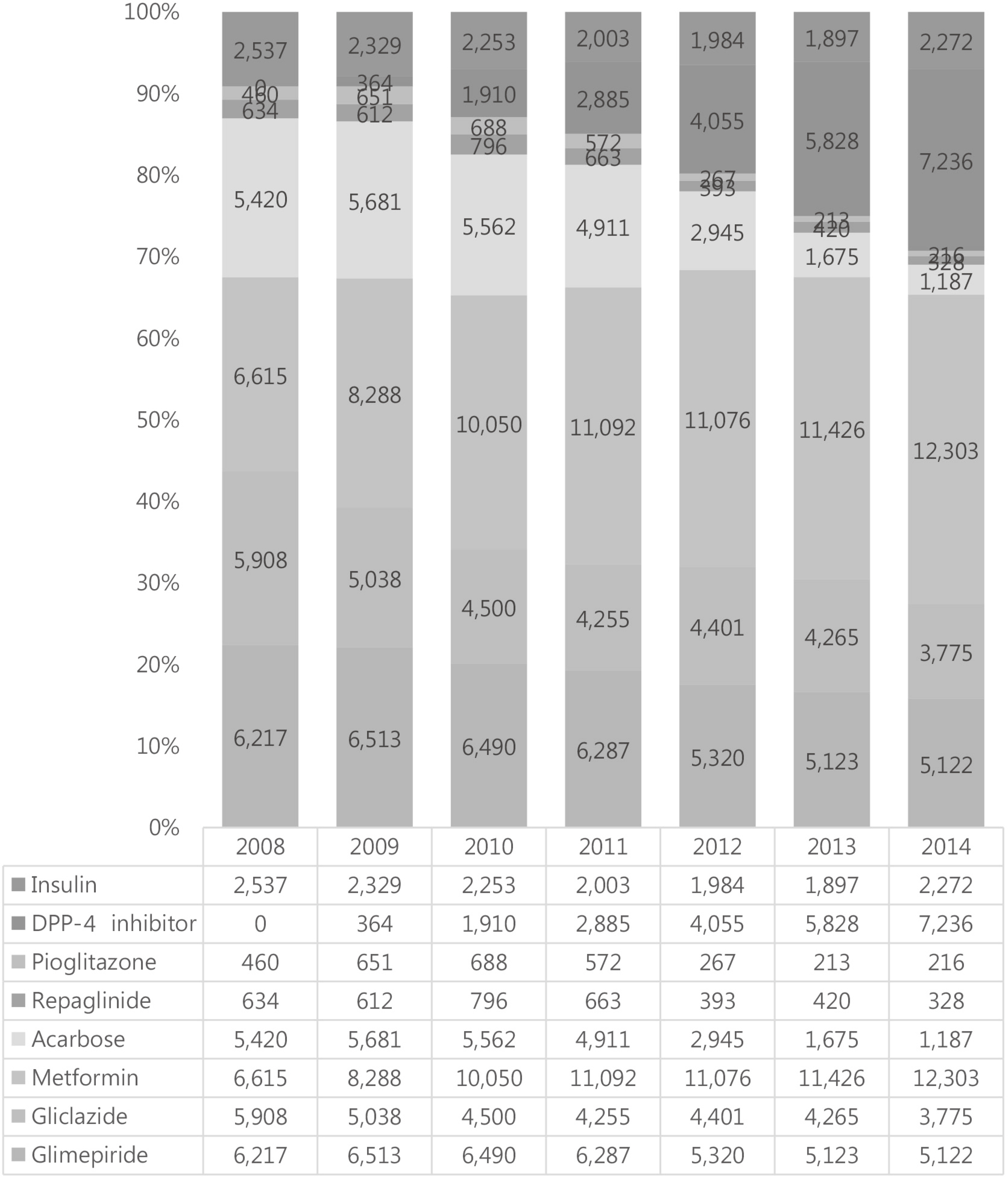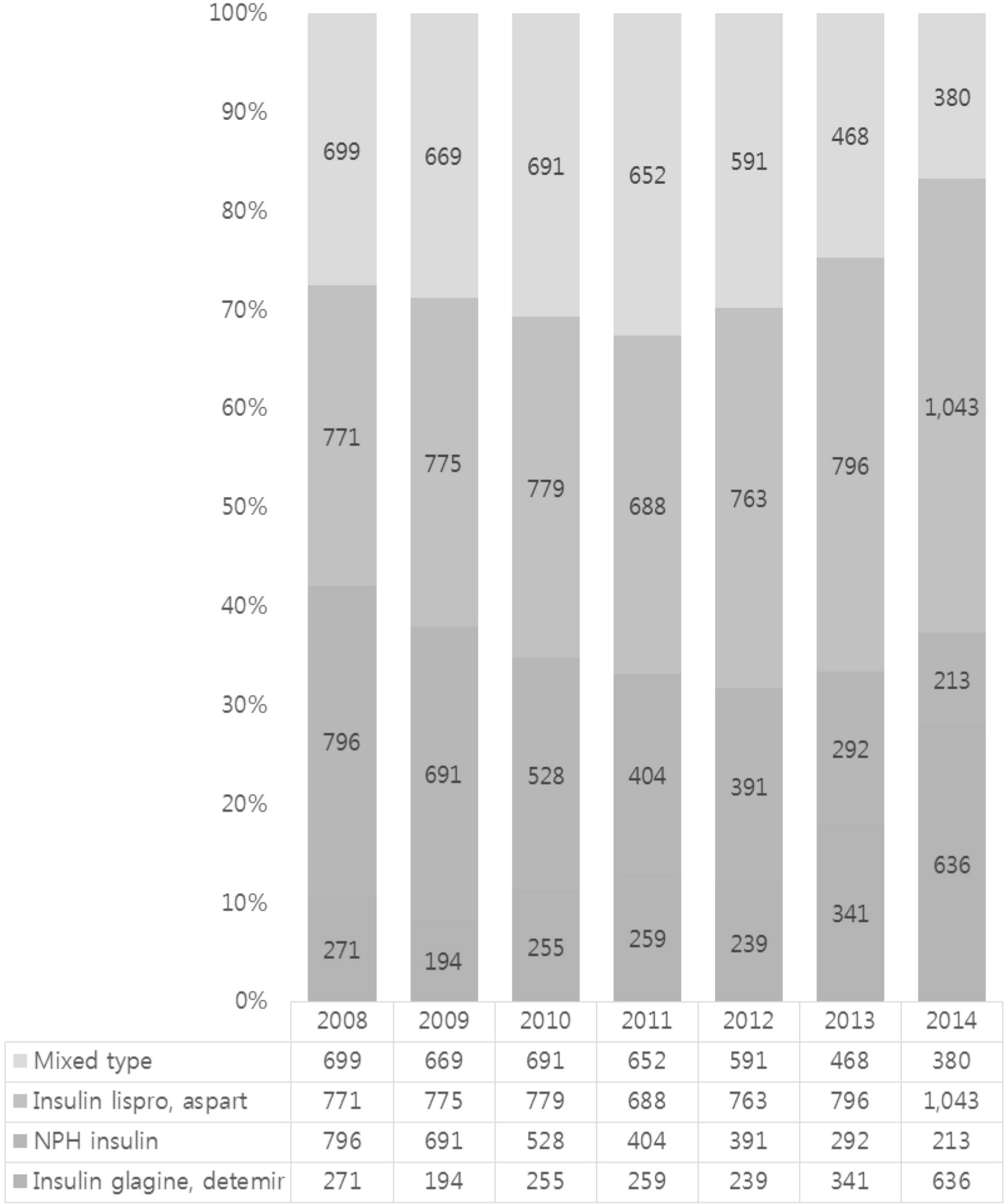J Korean Diabetes.
2016 Sep;17(3):202-211. 10.4093/jkd.2016.17.3.202.
Characteristics of Hypoglycemia Pateints Visiting the Emergency Department of a University Hospital
- Affiliations
-
- 1Department of Internal Medicine, Hallym University College of Medicine, Chuncheon, Korea. ohryu30@gmail.com
- 2Department of Nursing, Songgok College, Chuncheon, Korea.
- KMID: 2354286
- DOI: http://doi.org/10.4093/jkd.2016.17.3.202
Abstract
- BACKGROUND
Hypoglycemia is an important obstacle in the treatment of diabetes. When diabetic patients experience hypoglycemia, thorough glycemic control is more difficult. We evaluated the factors associated with risk of hypoglycemia and identified whether the demographic and clinical characteristics or the medication pattern changed during the study period.
METHODS
This study was conducted retrospectively with 7 years of data from one university hospital emergency department. We evaluated the medical records of 396 diabetic patients who visited the emergency room with hypoglycemia between January 2008 and December 2014. Hypoglycemia was defined as a serum glucose level less than 70 mg/dL or an event requiring the assistance of another person to actively corrective action.
RESULTS
The mean age, duration of diabetes, and hemoglobin A1c (HbA1c) of the study subjects were 71 ± 12.2 years, 12.7 ± 8.8 years, and 6.7 ± 1.39%, respectively. Among the subjects, 55% had a HbA1c level lower than 6.5%. Two-thirds of the study subjects received sulfonylurea, and one-third were treated with insulin. We observed a decreasing trend in the number of hypoglycemia cases during the study period. This trend might be partly explained by the decrease in sulfonylurea use and increase in dipeptidyl peptidase 4 inhibitor prescription during the study period.
CONCLUSION
The clinical characteristics of subjects with hypoglycemia were old age, long duration of diabetes, relatively low HbA1c, and comorbidities. We found that hypoglycemia events in diabetic patients decreased in number in conjunction with the changing pattern of use of hypoglycemic agents.
Keyword
MeSH Terms
Figure
Reference
-
References
1. The Diabetes Control and Complications Trial Research Group. The effect of intensive treatment of diabetes on the development and progression of longterm complications in insulindependent diabetes mellitus. N Engl J Med. 1993; 329:977–86.2. UK Prospective Diabetes Study (UKPDS) Group. Intensive blood-glucose control with sulphonylureas or insulin compared with conventional treatment and risk of complications in patients with type 2 diabetes (UKPDS 33). Lancet. 1998; 352:837–53.3. Seufert J. [ACCORD (Action to Control Cardiovascular Risk in Diabetes trial) becoming "two-tone"]. Dtsch Med Wochenschr. 2008; 133:1068–70.4. Cryer PE. Death during intensive glycemic therapy of diabetes: mechanisms and implications. Am J Med. 2011; 124:993–6.
Article5. American Diabetes Association. Standards of medical care in diabetes-2015 abridged for primary care providers. Clin Diabetes. 2015; 33:97–111.6. Seaquist ER, Anderson J, Childs B, Cryer P, Dagogo-Jack S, Fish L, Heller SR, Rodriguez H, Rosenzweig J, Vigersky R. Hypoglycemia and diabetes: a report of a workgroup of the American Diabetes Association and the Endocrine Society. Diabetes Care. 2013; 36:1384–95.
Article7. James PA, Oparil S, Carter BL, Cushman WC, Dennison-Himmelfarb C, Handler J, Lackland DT, LeFevre ML, MacKenzie TD, Ogedegbe O, Smith SC Jr, Svetkey LP, Taler SJ, Townsend RR, Wright JT Jr, Narva AS, Ortiz E. 2014 evidence-based guideline for the management of high blood pressure in adults: report from the panel members appointed to the Eighth Joint National Committee (JNC 8). JAMA. 2014; 311:507–20.8. Andrassy KM. Comments on ‘KDIGO 2012 clinical practice guideline for the evaluation and management of chronic kidney disease'. Kidney Int. 2013; 84:622–3.
Article9. Kim JT, Oh TJ, Lee YA, Bae JH, Kim HJ, Jung HS, Cho YM, Park KS, Lim S, Jang HC, Lee HK. Increasing trend in the number of severe hypoglycemia patients in Korea. Diabetes Metab J. 2011; 35:166–72.
Article10. UK Hypoglycaemia Study Group. Risk of hypoglycaemia in types 1 and 2 diabetes: effects of treatment modalities and their duration. Diabetologia. 2007; 50:1140–7.11. Duckworth W, Abraira C, Moritz T, Reda D, Emanuele N, Reaven PD, Zieve FJ, Marks J, Davis SN, Hayward R, Warren SR, Goldman S, McCarren M, Vitek ME, Henderson WG, Huang GD. VADT Investigators. Glucose control and vascular complications in veterans with type 2 diabetes. N Engl J Med. 2009; 360:129–39.
Article12. ADVANCE Collaborative Group. Patel A, MacMahon S, Chalmers J, Neal B, Billot L, Woodward M, Marre M, Cooper M, Glasziou P, Grobbee D, Hamet P, Harrap S, Heller S, Liu L, Mancia G, Mogensen CE, Pan C, Poulter N, Rodgers A, Williams B, Bompoint S, de Galan BE, Joshi R, Travert F. Intensive blood glucose control and vascular outcomes in patients with type 2 diabetes. N Engl J Med. 2008; 358:2560–72.13. Nichols GA, Joshua-Gotlib S, Parasuraman S. Glycemic control and risk of cardiovascular disease hospitalization and all-cause mortality. J Am Coll Cardiol. 2013; 62:121–7.
Article14. Yong YM, Shin KM, Lee KM, Cho JY, Ko SH, Yoon MH, Kim TW, Jeong JH, Park YM, Ko SH, Ahn YB. Intensive individualized reinforcement education is important for the prevention of hypoglycemia in patients with type 2 diabetes. Diabetes Metab J. 2015; 39:154–63.
Article15. Sicras-Mainar A, Navarro-Artieda R. Economic impact of combining metformin with dipeptidyl peptidase-4 inhibitors in diabetic patients with renal impairment in spanish patients. Diabetes Metab J. 2015; 39:74–81.
Article
- Full Text Links
- Actions
-
Cited
- CITED
-
- Close
- Share
- Similar articles
-
- Patient Education to Prevent Hypoglycemia
- The Severity of the Pediatric Patients Visiting Emergency Center
- The degree of Satisfaction with Nursing Care of Pediatric patients visiting Emergency Center
- A Case Report of Rare Adverse Events Associated with Venlafaxine Administration: Hypoglycemia and Lactic Acidosis
- Severe hypoglycemia in the elderly diabetes




